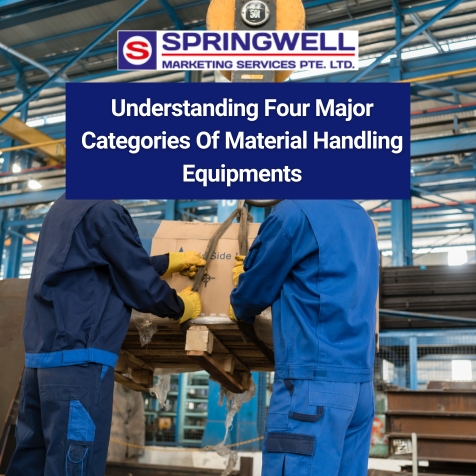
Understanding Four Major Categories Of Material Handling Equipments

When it comes to material handling, there are various types of equipment that are used in different industries and applications. These equipments play a crucial role in the efficient movement, storage, and control of materials within a manufacturing or distribution facility.
Today, we will discuss the four major categories of material handling equipment: storage and handling equipment, industrial trucks, bulk material handling equipment, and engineered systems.
Why Should You Understand The Different Categories Of Material Handling Equipments?
Understanding the different categories of material handling equipment is essential for several reasons:
- It helps select the right equipment for your specific application or industry.
- It ensures safe and efficient material handling operations.
- It increases productivity and reduces downtime.
- It minimises damage to materials and products during handling.
- It improves operational efficiency and cost-effectiveness.
Category 1: Storage And Handling Equipment
Storage and handling equipment are used for storing, organising, and transporting materials within a facility. These include pallet racks, shelving systems, bins, drawers, carts, conveyors, and automated storage and retrieval systems (AS/RS).
- Pallet racks and shelving systems are the most common type of storage equipment. They provide vertical storage space, making it easier to store and retrieve materials. Bins, drawers, and carts are used for smaller items and can be easily moved around the facility.
- Conveyors are used to transport materials from one location to another within a facility. They come in various types, such as roller, belt, chain, and skate-wheel conveyors.
- Automated storage and retrieval systems (AS/RS) are computer-controlled systems that automatically store, retrieve, and sort materials. They are often used in large-scale warehouses for efficient storage and retrieval of materials.
Category 2: Industrial Trucks
Industrial trucks are motorised vehicles that are used for lifting, moving, and transporting materials within a facility. These include forklifts, pallet jacks, reach trucks, and order pickers.
- Forklifts are the most common industrial truck used for lifting and transporting materials. They come in various sizes and can handle different weights and load types.
- Pallet jacks are used for moving pallets within a warehouse or storage facility. They are smaller than forklifts, but can only move horizontally.
- Reach trucks and order pickers are used for retrieving materials from high shelves or racking systems. They have extending arms that allow them to reach higher levels.
Category 3: Bulk Material Handling Equipment
Bulk material handling equipment is used for moving large quantities of materials, such as grains, minerals, chemicals, or liquids. These include conveyor belts, bucket elevators, stackers, and reclaimers.
- Conveyor belts are the most common type of bulk material handling equipment. They are used for transporting materials in a continuous stream along a specified path.
- Bucket elevators are used for vertically lifting or lowering materials in bulk quantities. They consist of buckets attached to a revolving belt or chain.
- Stackers and reclaimers are used for stockpiling and reclaiming large quantities of materials. They can store materials in organised piles and retrieve them when needed.
Category 4: Engineered Systems
Engineered systems are customised solutions that combine various types of material handling equipment to handle specific tasks or processes within a facility. These can include automated assembly lines, robots, and material handling integrated systems.
- Automated assembly lines use a combination of conveyors, robots, and other machinery to automate production processes. They are used for high-volume production and reduce the need for manual labour.
- Robots are used in material handling applications that require precision and efficiency. They can perform tasks such as picking up and placing items, sorting materials, or stacking pallets.
- Material handling integrated systems combine various types of equipment to create a streamlined process for moving materials within a facility. They can include conveyor systems, robotic arms, and automated storage systems.
What Are The Common Considerations When Choosing Material Handling Equipment?
When choosing material handling equipment, there are several factors to consider, including:
- The type of materials being handled (size, weight, shape)
- The layout and size of the facility
- The required speed and efficiency of material handling operations
- The safety features and regulations for the specific industry or application
- Any special requirements or processes that need to be accommodated.
Understanding these considerations can help you select the right equipment for your specific needs and ensure safe and efficient material handling operations.
Takeaway
Material handling equipment plays a crucial role in the efficient and safe movement, storage, and control of materials within a facility.
By understanding the different categories of equipment and their uses, you can make informed decisions when selecting equipment for your specific applications.
Consider factors such as materials being handled, facility layout, and safety regulations to choose the most suitable equipment for your operations.
Springwell, Your Choice For Material Handling Equipment
At Springwell, we offer a wide range of material handling equipment to meet your specific needs.
From storage and handling equipment to industrial trucks, we have the expertise and experience to provide customised solutions for your facility.
Contact us today to learn more about our products and services, and see how we can help optimise your material handling operations.

